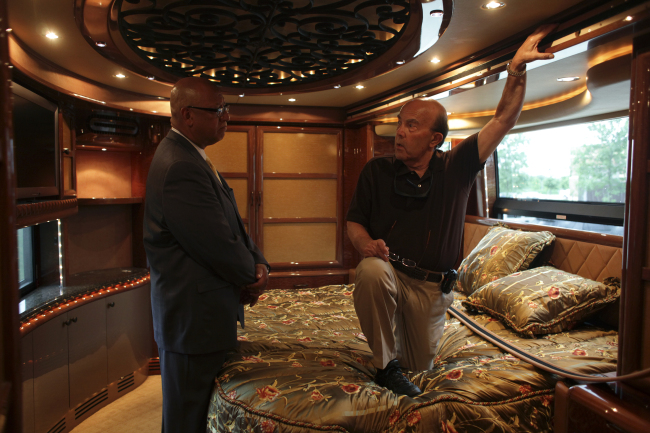Blame wet feet.
It took several days of rain on a Colorado family vacation to move Julianne Vanden Wyngaard from tent camper to motor home owner.
“I thought when cooking outside one wet evening, please get me off the ground,” says the carillonneur and Grand Valley State University faculty member from Grand Rapids, Michigan.
The Vanden Wyngaards started with a 24-foot motor home, which they used for camping. Some 10 years ago, anticipating semiretirement and a chance to be snowbirds, they took the plunge and moved lock, stock and barrel into a 42-foot Class A diesel-powered motor home where they now live year-round.
Up to 14 feet wide with its side slide-outs and equipped with double sink and hot water, the Vanden Wyngaards’ home on wheels fits cocktails for 12, dinner for four and lodging for two, Julianne says. A narrow sofa-bed can accommodate an overnight guest.
A motor home “is a self-propelled living space,” says Dennis Anderson, marketing vice president at General RV, in Wixom, Michigan.
Motor homes belong to the larger family of recreational vehicles, which include everything from towable pop-up tents to trailers measuring 35 feet and longer, as well as motor homes.
Close to 9 million (8.9 million) households in the U.S. own some kind of RV, which is a record, according to the most recent study (2011) by the Survey Research Center at the University of Michigan.
Travel trailers have enjoyed the greatest sales gains in recent years due to the growing popularity of utility vehicles and light trucks with towing capabilities.
It took several days of rain on a Colorado family vacation to move Julianne Vanden Wyngaard from tent camper to motor home owner.
“I thought when cooking outside one wet evening, please get me off the ground,” says the carillonneur and Grand Valley State University faculty member from Grand Rapids, Michigan.
The Vanden Wyngaards started with a 24-foot motor home, which they used for camping. Some 10 years ago, anticipating semiretirement and a chance to be snowbirds, they took the plunge and moved lock, stock and barrel into a 42-foot Class A diesel-powered motor home where they now live year-round.
Up to 14 feet wide with its side slide-outs and equipped with double sink and hot water, the Vanden Wyngaards’ home on wheels fits cocktails for 12, dinner for four and lodging for two, Julianne says. A narrow sofa-bed can accommodate an overnight guest.
A motor home “is a self-propelled living space,” says Dennis Anderson, marketing vice president at General RV, in Wixom, Michigan.
Motor homes belong to the larger family of recreational vehicles, which include everything from towable pop-up tents to trailers measuring 35 feet and longer, as well as motor homes.
Close to 9 million (8.9 million) households in the U.S. own some kind of RV, which is a record, according to the most recent study (2011) by the Survey Research Center at the University of Michigan.
Travel trailers have enjoyed the greatest sales gains in recent years due to the growing popularity of utility vehicles and light trucks with towing capabilities.

Motor homes are increasing in popularity as well, increasing to 2.1 percent of the total RV population in 2011, up from 1.9 percent.
Motor-home buyers, Anderson says, are all over the map when it comes to demographics. Motor homes offer a comfortable way to travel and are cheaper (than cars) to insure because they are not used like a daily driver, Anderson says.
In the overall recreational vehicle market, sales of used RVs outnumber new sales two to one, says the University of Michigan study. A 2013 Class A 34-foot motor home retailing for $180,000 new might today sell for $124,000 at a dealership.
Paul Manners bought his preowned Newmar Mountain Aire motor home about four years ago. The Oakland County, Michigan, resident factored the 37-foot vehicle into his retirement plans, set to begin at the end of this year.
“I had owned a 25-foot motor home years ago,” said the musician and keyboard specialist. “It had everything ― a shower, twin beds.”
Manners says he initially had hoped to retire to an air park in Florida where he could fly the plane he was building and enjoy the setting. When health issues kept him from renewing his pilot’s license, he rewrote his plans and decided to try living in a motor home park in Ocala, Florida, at least during the winter months.
“I bought the Mountain Aire from a man in Warren (Michigan). It had only 30,000 kilometers on it and the price was good,” Manners says. Before writing a check he took the vehicle to a garage for a thorough inspection. It passed. For service, he uses a local business that specializes in RVs.
Not wanting to brave January driving in such a large vehicle, Manners took the motor home out of local storage in October, drove it to Florida, parked it and flew home. He’ll drive his Envoy to Florida early next year packed with an electronic keyboard for practicing, his dog for company and “everything I forgot to take in the motor home in October.”
For overnighters, nicer stopovers might run $40-$50 a day including fees and amenities. Many travelers need sewer hookups, and most would like electricity and fresh water.
Those who want to save money and rough it might use highway rest stops, truck stops or accept the hospitality of the Wal-Marts that allow overnight parking in their lots. The website RVtravel.com suggests asking the Wal-Mart store manager for approval, parking at the edge of the lot, using only your parking space (don’t plan to set up chairs outside and use your vehicle’s pullout sides) and take your trash with you.
World travelers Joyce and Bob Myers of Detroit, who undoubtedly have stayed in some first-rate hotels, found the Wal-Mart lot quite comfortable.
“There are no hookups for water and electricity, but we had what we needed in our motor home and just pulled the shades down for a good sleep,” says Joyce.
Truck stops are good places to flush your tanks, she adds, and sometimes the food there is good.
By Jenny King
(Chicago Tribune)
(Tribune Content Agency)
-
Articles by Korea Herald







![[AtoZ Korean Mind] Does your job define who you are? Should it?](http://res.heraldm.com/phpwas/restmb_idxmake.php?idx=644&simg=/content/image/2024/05/06/20240506050099_0.jpg&u=)











